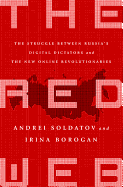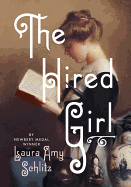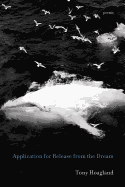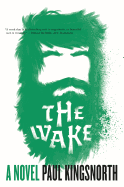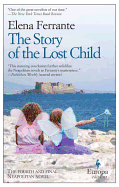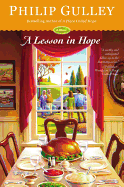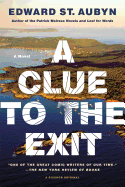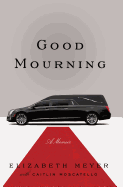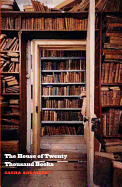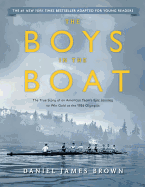Friday, September 11, 2015
In December 1987, I was flying back from the Caribbean island of Guadeloupe, where I'd spent the week covering a World Cup windsurfing competition for Sailboard News. My seatmates on the Air France flight were both lifelong surfers, one the editor of a California windsurfing magazine and the other a freelance photographer. Charting a course northwest, their eyes seldom left the window as they scanned the chain of islands far below for notable wave breaks.
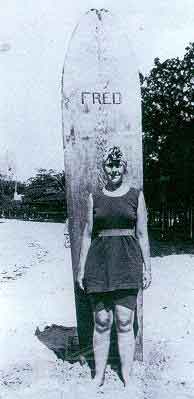 |
|
| Agatha Christie, 1922 (photo: British Museum of Surfing) | |
I thought of those guys recently after reading about an Agatha Christie photo exhibition in London marking the 125th anniversary of her birth. According to the Guardian, among the show's attractions were "photographs of her surfing on to an idyllic Muizenberg beach in South Africa."
Tell me the truth. When you think of surfing, who comes to mind first: the Beach Boys or Agatha Christie? And yet, Christie "was something of a pioneering and diehard wave-rider," as the Guardian noted a few years ago. Miss Marple's creator and her first husband "may been among the first Britons to learn how to surf standing up."
As a reader at least, surfing has been on my radar ever since I worked for that windsurfing magazine. In recent years, I've read several fascinating books about the sport and lifestyle, including William Finnegan's Barbarian Days: A Surfing Life; Chas Smith's Welcome to Paradise, Now Go to Hell; and The Wave: In Pursuit of the Rogues, Freaks and Giants of the Ocean by Susan Casey. Tim Winton's Breath is my favorite surfing novel.
In her autobiography, Christie writes that while staying in Hawaii she "learned to become expert--or at any rate expert from the European point of view--the moment of complete triumph on the day that I kept my balance and came right into shore standing upright on my board!"
I'm not a surfer, but I understand the learning curve. And I'll never forget that image of my colleagues gazing out a jet window, reading the waves. --Robert Gray, contributing editor
The Wake
by Paul Kingsnorth
The Wake is a singular debut novel by Paul Kingsnorth (One No, Many Yeses; Real England), set in England immediately following the Norman invasion of 1066. Its first-person narrator is a landowner named Buccmaster, who has lost everything to the attack: his family, his home, his land and his privilege. He takes to the fens and woods, with revenge in his heart and an intention to drive the French from his land and all of England. There he becomes one of the guerrilla fighters known as green men, whose chapter in history is little known.
What makes this powerful story distinctive is Kingsnorth's decision to write the story in what he calls a "shadow tongue," an Old English hybrid of the author's invention, made slightly more understandable to the modern reader. (Hint: try reading aloud, to hear cognates and the rhythm of the speech.)
The Wake is an ambitious novel in its themes and scope, in addition to its unusual linguistic decisions. As the English folc in his story become disconnected from their land, they lose their freedom: "if the frenc cums and tacs this land and gifs these treows [trees] sum frenc name they will not be the same treows no mor." As an impassioned defense of the natural world and people's responsibilities toward it, the novel acts as a metaphor for modern times. Buccmaster's personal narrative is a lesson in pride and its dangers, a glimpse of another culture in its own language. Kingsnorth's captivating first novel is thought provoking, multi-faceted and intriguingly rendered. --Julia Jenkins, librarian and blogger at pagesofjulia
Discover: A novel of resistance to the Norman Invasion, told in a hybrid of Old English.
The Story of the Lost Child
by Elena Ferrante, transl. by Ann Goldstein
Like the previous novels in Elena Ferrante's Neapolitan quartet, the concluding volume, The Story of the Lost Child, is ferociously, compulsively readable. The story is laced with earthquakes and death threats, sibling betrayals and old animosities. Ferrante is a remarkable storyteller and knows just how much to tell every step of the way.
Nothing in this Neapolitan neighborhood stays the same for long. Shops close. Crime is on the rise. Friends who grew up together switch spouses like dance partners. Fiery, outspoken Lila, more mercurial than anyone, is seen as the only person capable of putting the neighborhood right. The strongest bond in Ferrante's quartet remains Lila's passionate, lifelong devotion to bookish, intellectual Elena, who is infamous after the success of her novel exposing local corruption.
Throughout all four volumes, Lila grows and changes before the reader's eyes. As two characters who are perfect foils for each other, Elena and Lila face the erratic turmoil of their intertwined lives in consistently revealing ways. Again and again, Ferrante takes the reader back to the first novella in My Brilliant Friend, in which the two girls lose their dolls. Each time she gives the account more nuance, more background information, until the initial novella in the first volume of the quartet is seen to contain the seeds of what will follow. Ultimately the plot comes full circle back to the beginning of the quartet, the framing story of Lila's disappearance, with one final moment that brings to a perfect close one of the greatest literary achievements of the new century. --Nick DiMartino, Nick's Picks, University Book Store, Seattle, Wash.
Discover: The concluding novel of a saga about two women's 66-year friendship in a rough neighborhood of Naples.
A Lesson in Hope
by Philip Gulley
Philip Gulley spent nine books exploring the ups and downs in the life of Sam Gardner, fictional pastor of the local Quaker church in Harmony, Ind. After taking a brief hiatus from the Harmony series, Gulley reintroduced Sam, his wife, Barbara, and their two sons in A Place Called Hope, in which Sam wound up as the last-minute substitute officiate at a same-sex wedding. This created quite a stir, ultimately uprooting the family from Harmony to Hope, Ind.
In A Lesson in Hope, Sam and Barbara's sons have flown the coop--one in college, one serving in the military. While Pastor Sam's focus is on managing and growing the Hope Friends Meeting Church, a 98-year-old member, Olive Charles, dies and leaves her million-dollar estate to the meeting. Everyone in the parish--and even the larger Quaker Church--has designs on how to spend the money. Sam faces a host of additional complications when Olive's long-lost niece takes legal action challenging the bequest. Add to this a member fascinated by girlie magazines, another withering from Alzheimer's. Sam flirts with temptations of his own, one son dates a Methodist, the other dabbles in Mormonism, and Sam's high-maintenance parents contemplate a move to Hope.
Gulley's continuing good-natured and humorous series examines the often-peculiar nuances and drama of contemporary small-town life, and the entertaining quirks and foibles of a memorable cast of recurrent characters who try to keep the faith--and their wits about them. --Kathleen Gerard, blogger at Reading Between the Lines
Discover: The continuing saga of a small-town pastor as he tries to keep the peace over a million-dollar bequest to his Quaker Meeting.
Gateway to Paradise: Stories
by Matthew Vollmer
There's a certain wedge of the American South where mountains give way to idyllic college towns and tall tales give way to the ghosts that inspired them. It's the geographical confluence of truth and fiction, history and folklore, and Matthew Vollmer mines that rich terrain in Gateway to Paradise, a collection of short stories that follows disparate lives entangled in the Appalachians like vines of kudzu, tethered by secrets and stories.
"Downtime," the first piece in the book, signals Vollmer's style--a mélange of down-and-out personas with a splash of Dixie magic--like a flare. Following the loss of his wife, dentist Ted takes his lover and receptionist, Allison, to Gatlinburg, Tenn., where they intend to drink, screw and sight-see, away from the prying eyes of their small hometown. The plan's hitch arrives in the form of Ted's ex-wife, whose drowned, barnacled corpse follows him around the hotel, seducing him despite her clammy, mottled skin.
Vollmer's best stories have a ring of truth, despite their oddity. "The Visiting Writer" lacks the high stakes and whimsy of the stories that surround it, yet its uncanny sincerity, including the mediocre hors d'oeuvres served at a university cocktail party and a famous writer's peculiarities, reflect reality through an strange mirror. "Dog Lover" disturbs more than provokes (toward the story's end the title suddenly becomes quite literal), but the rest of the collection proves winsome. Gateway to Paradise heralds the arrival of a new voice rooted in place, a place whose eccentrics and eccentricities are almost stranger than fiction. --Linnie Greene, freelance writer
Discover: These outlandish short stories centered in the Appalachian South chronicle the lives of characters as distinct and magnetic as the region they inhabit.
A Clue to the Exit
by Edward St. Aubyn
Edward St. Aubyn (Mother's Milk) calls A Clue to the Exit his favorite of his own novels. Originally published in 2000, it's now being reissued by Picador.
Charlie is a hack screenwriter who's just been told he has six months to live. He starts driving more carefully, even as he considers suicide, experimenting with the proper response to this news. He contacts his ex-wife about seeing his daughter; he sells his house and takes half his riches to Monte Carlo to lose it as quickly as possible. And, suddenly inspired, he sets out to write a serious novel--much to his agent's exasperation.
St. Aubyn's craft is on full display with this inward-looking work of simultaneous parody and earnestness. Nearly every line is quotable, a small but shining victory of prose. Charlie's novel, On the Train, visits with Proust and Buddha, while "a clue to the exit" references Henry James on "the human maze," but alongside serious, even wearying considerations, Charlie's story is often very funny and self-referential. A third-person narrative "is so much more personal than a first-person narrative, which reveals too flagrantly the imposture of the personality it depends on," writes St. Aubyn in Charlie's voice: A Clue to the Exit is told in first-person, while On the Train is in the third. This feedback loop is a central device. "Feeling too upset to write, I made the brave decision to write about feeling too upset."
A refined and stylish novel of cynicism and the question of death, A Clue to the Exit is a perfect sample of St. Aubyn's craft. --Julia Jenkins, librarian and blogger at pagesofjulia
Discover: Edward St. Aubyn's favorite of his own novels, a clever, sophisticated consideration of death and consciousness.
Biography & Memoir
Good Mourning: A Memoir
by Elizabeth Meyer, with Caitlin Moscatello
Good Mourning is the story of one young woman's journey from socialite to funeral director at an elite Manhattan mortuary. Dryly funny and gossipy--names have been changed, but there are enough details to enable guessing games--Elizabeth Meyer's memoir offers reflections on growth, grieving and how modern Americans deal with death.
Raised in the privileged realm of the Upper East Side, Meyer was not long out of New York University when her father died after a lengthy battle with cancer. She threw herself into planning his funeral, working with the Crawford Funeral Home to create a meaningful event where friends and family would celebrate his life. She was surprised to discover she had a knack for it. She was even more surprised to find she couldn't stop thinking about Crawford, and she was back there soon after, talking her way into a job.
Meyer's choice to work with the dead confused her friends and family, but she couldn't shake off her fascination. Hired as a receptionist, she eagerly observed business operations, jumped at opportunities and spent her free time in the embalming room. However, her real talent was in dealing with Crawford's upscale clientele; they appreciated both her empathy and her ability to respond to their idiosyncratic needs with thoughtfully crafted farewell events.
Meyer's anecdotes about funerals make Good Mourning entertaining reading: those sparing no expense, those with exclusive guest lists and for a bigamist (he got two), and cadavers that were missing organs or went missing entirely. Moreover, her insights about the business of death and how we approach it give this memoir a broader focus and unexpected depth. --Florinda Pendley Vasquez, blogger at The 3 R's: Reading, 'Riting, and Randomness
Discover: Her father's death led a young woman to discover a gift, and a passion, for funeral planning.
Current Events & Issues
The Red Web: The Struggle Between Russia's Digital Dictators and the New Online Revolutionaries
by Andrei Soldatov and Irina Borogan
The collapse of the Soviet Union unleashed freedom and chaos in equal measure on the Russian people. A society where information was once strictly controlled suddenly opened to the antithesis of censorship and repression--the Internet. As Western capital flooded into the new Russian Federation during the 1990s, digital networks sprouted from fledgling Internet service providers and connected Russians with each other and the world online. It was a time of turbulence, but also of optimism among the Russian intelligentsia.
Then came Vladimir Putin. The former KGB agent rose from St. Petersburg bureaucrat to Russian president by 2000. His consolidation of power meant strangling critical free media: first television stations, then print publications and, most recently, the Internet. The Red Web describes how Putin's authoritarianism has fueled blacklists banning "objectionable" websites and the ubiquitous use of SORM, a small device that allows the FSB (successors of the KGB) to monitor everything that passes through Russian servers, including e-mails and social network posts. Even foreign companies like Google and Twitter are increasingly cooperating with Putin.
Russian journalists Andrei Soldatov and Irina Borogan (The New Nobility), co-founders of security services watchdog Agentura.ru, are among those dissidents pushing back against Putin's Internet power grab. In The Red Web, they expose the history of mass surveillance in the Soviet Union, its reemergence in the Russian Federation, and how Putin's crackdown on free media fits into his overall totalitarian scheme. But, according to the authors, Putin is handicapped by his own KGB worldview, where dissident organizations can be decapitated and defeated. The decentralized power structure of the Internet may yet be Putin's undoing. --Tobias Mutter, freelance reviewer
Discover: Russian journalists expose Internet censorship and surveillance in Putin's Russia.
Business & Economics
The Lion Awakes: Adventures in Africa's Economic Miracle
by Ashish Thakkar
"It's time to stop patronizing Africans and seeing us as victims in need of alms," Ashish Thakkar writes. "Instead of giving us gifts, trade with us, buy from us and invest in us. You will benefit from this as much as we will." Thakkar is the founder of Mara Group, an African business conglomerate with 11,000 employees, and of the Mara Foundation for emerging young African entrepreneurs. In 2014, Forbes named him one of the 10 most powerful men in Africa.
In The Lion Awakes, Thakkar tells the dramatic story of his family, Indian-Ugandans for three generations before Idi Amin exiled them to the U.K. They moved to Rwanda just before the genocide, then fled back to Uganda. There, Thakkar dropped out of school at age 15 to start an IT business. His personal story is impressive enough, but The Lion Awakes is also an investor's tour of the exploding African business scene over the past decade, full of case studies, statistics, information resources and tips for success.
Thakkar has an insider's view of small businesses, as well as luxury hotels and tech hubs. In enthusiastic, inspirational terms, he describes the political, economic and educational changes that have made this entrepreneurial surge possible. His main focus is the tech industries, but he also looks at entertainment, agriculture, fashion and architecture. And he shows how the general global recession is inspiring a wave of immigration to Africa by educated Africans, Europeans and Asians "taking a shot at the African Dream." --Sara Catterall
Discover: An exciting African economic boom driven by a creative and ambitious new generation of entrepreneurs.
The House of Twenty Thousand Books
by Sasha Abramsky
Journalist Sasha Abramsky's first book is a warmhearted, frank memoir of his bibliophile grandfather, scholar and collector Chimen Abramsky, and the extraordinary book-filled London home where he lived for 66 years.
The son of prominent Orthodox rabbi Yehezkel Abramsky, Chimen rejected Judaism for another religion--Communism--as a young man. Though lacking a degree from a British university, he went on to become a leading scholar of Marxism and collector of Marxist literature. His books packed every available space in what his grandson calls the House of Books, in North London's Highgate neighborhood. By 1958, however, Chimen, disillusioned by the revelations of Stalin's atrocities and anti-Semitism, had severed his ties with the Communist Party. That repudiation ushered in the second phase of his intellectual life, as his interests pivoted to Jewish literature and Judaica.
Without a catalogue of his grandfather's library, Abramsky acknowledges that the book count reflected in his title may be imprecise, but as he describes the "staggering" number of books, it's easy to picture the "unfathomable clutter" that defined the home. The book is structured around a tour of its cramped rooms, each one "lined from floor to ceiling with shelves double-stacked with books, with just a few bare spots left in which paintings and photographs hung."
Balancing affection with a sense of awe at the story of his grandfather's fascinating life, Sasha Abramsky has produced a work that will appeal to book lovers and readers of family memoir. --Harvey Freedenberg, attorney and freelance reviewer
Discover: Sasha Abramsky's memoir shares the story of his grandfather's passionate, book-filled life.
Poetry
Application for Release from the Dream: Poems
by Tony Hoagland
While Hoagland does more than merely dip his toe in the darkness, he never lets it swallow him whole. He looks for and finds slivers of salvation. When his wife of six years reveals in "Don't Tell Anyone" that "she screams underwater when she swims," the narrator shrugs and suggests, "For all I know, maybe everyone is screaming silently/ as they go through life."
After rambling along from one amusing, troubling experience to another, Hoagland suggests one sure path to succor from the perils of life and diminishment of aging. In "There Is No Word," he finds redemption in language:
"how, over the years, it has given me
back all the hours and days, all the
plodding love and faith, all the
misunderstandings and secrets and mistakes
I have willing poured into it."
So put your boots up on the dash, pop a cold one and enjoy Hoagland's well-crafted evocative thoughts and humor. --Bruce Jacobs, founding partner, Watermark Books & Cafe, Wichita, Kan.
Discover: Tony Hoagland's poems are full of aging narrators coming to grips with their lives of misunderstandings and mistakes.
Children's & Young Adult
The Hired Girl
by Laura Amy Schlitz
Fourteen-year-old Joan Skraggs wants to write in her diary with ''truth and refinement,'' as her beloved teacher Miss Chandler suggests, but how can she when her drudging life of privy-scrubbing for her family is so terribly vulgar?
In Newbery winner Laura Amy Schlitz's The Hired Girl, Joan wants nothing more than to get an education and become a schoolteacher, as her late mother wanted. There's one hulking obstacle, and that's her father, a bitter man who calls her ''an ox of a girl.'' The year is 1911, the place rural Pennsylvania, and opportunities for farm girls are few. She vows to escape to the big city, reasoning that if she's going to live a life of servitude, she might as well at least be paid $6 a week for it. Fueled by desperation, Joan is able to flee by train to Baltimore. A romantic sort, she changes her name to ''Janet Lovelace'' and winds up in the wealthy Rosenbachs' elegant Jewish home as a hired girl, ''a kind of Gentile Cinderella.'' Janet is an aspiring Catholic, and her crash course in Judaism is not only instructive for the uninitiated, but often farcical, as when she infuriates the elderly servant Malka by unwittingly violating kosher traditions. Janet's earnest theological musings are humorously contrasted with more worldly concerns, from stylish hats to stray cats to her ardent, forbidden love for the Rosenbachs' artist son, David.
Fans of Little Women, rejoice. Joan's impassioned diary, inspired by Schlitz's own grandmother's journals, explores themes of faith and feminism, love and literature, culture and class in early 20th-century America, all the while charming readers with a vivid cast of characters. --Karin Snelson, children's editor, Shelf Awareness
Discover: Newbery author Laura Amy Schlitz's deliciously dramatic diary of a Pennsylvania farm girl who escapes to Baltimore in 1911 to forge a new life for herself.
Gryphons Aren't So Great
by Andrew Arnold, James Sturm, and Alexis Frederick-Frost
The team behind Adventures in Cartooning returns for a funny and poignant comics-style tale of chivalry and friendship.
In the opening pair of horizontal panels, a knight in full armor rides a horse named Edward: "Faster, Edward! Faster!" cries the knight. Blue skies turn to a surreal yellow background as the knight shouts, "We're flying! Yee-haw!" and they sail off a cliff and splash into the water below. Knight and horse joyfully embrace and prepare to "do it again" when a winged gryphon (eagle in front, lion in back) approaches. Edward bravely tries to protect his friend from the swooping gryphon who knocks him down, but to no avail. The gryphon scoops up the knight and takes off into the sky. "I'm flying for real!" cries the knight. "This is amazing!!!" Though the rider promises his steed, "I'll be right back.... Weeeeee," a windowpane quartet of images show day turning to night as Edward waits patiently for the return of his friend.
This disarming tale probes the unsettling dynamics of a third person's intrusion into a close friendship. The sequences begin humorously, but quickly tap into authentic feelings of abandonment. All ends well, however, as Edward proves himself to be a far better friend to the knight than the not-so-great gryphon. Exquisitely paced full-page images and panels toggle between horizontal and vertical sequences, maintaining the right balance between empathy and humor, outward action and internal growth. For budding cartoonists, the endpapers provide step-by-step instructions on how to draw the main characters. --Jennifer M. Brown, former children's editor, Shelf Awareness
Discover: A story told in comic-strip panels of a close friendship between a knight and his horse, and a not-so-great gryphon who gets in the way.
The Boys in the Boat: The True Story of an American Team's Epic Journey to Win Gold at the 1936 Olympics
by Daniel James Brown, adapted by Gregory Mone
Daniel James Brown's The Boys in the Boat (2013), the absorbing, suspenseful account of an American rowing crew's gold-medal win at the 1936 Berlin Olympics, is "a story about growing up," says the author in his introduction to this young readers' edition of his runaway bestseller.
Brown explains that young people at his readings inspired this version, which minimizes the historical context of 1930s America and the rise of Nazi Germany to focus more on the human drama: "What they recognize in the story... is the sheer excitement of being young, having a goal, striving to accomplish that goal, and making it happen, just as the boys in the boat did." The nonfiction narrative revolves around Washington native Joe Rantz (the author's neighbor's father), one of nine young men from the University of Washington who stunned everyone, including Adolf Hitler, with their Olympics gold-medal win. It was hard work. In chapter one, readers meet Joe as freshman at the UW. He learns quickly that rowing takes "raw power, superhuman stamina, and solid intelligence." Flashbacks to Joe's impoverished, turbulent childhood (he was abandoned at 15) show he's made of tougher stuff than some wannabe rowers in their "expensive cardigans." The transcendent beauty of fine-tuned teamwork in the boat and vividly described, heart-pounding racing scenes swirl around Joe's often heart-rending personal story, always, impressively, the narrative's anchor. Black-and-white photos keep the sense of history alive throughout.
This heartening account of how nine scrappy young men persevere to win Olympic gold may inspire a few to try their oars in the water, metaphorically or otherwise. "Row!" --Karin Snelson, children's editor, Shelf Awareness
Discover: A young readers' adaptation of The Boys in the Boat, an against-all-odds story of a crew of rowers from Washington State and their 1936 Olympics gold-medal win.


